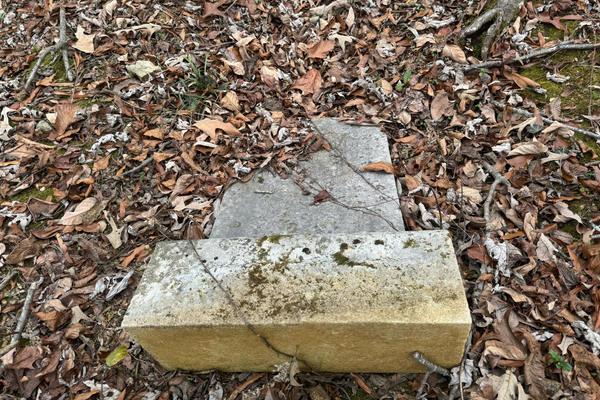
Fixing the World’s Oldest Trolleys Is Like Solving a Century-Old Jigsaw Puzzle
As mechanics at the Car Barn in Dallas know, you can’t just order a part from 1909.
The Car Barn sits adjacent to a timeworn cemetery, tucked away from a cluster of upscale restaurants in the Uptown neighborhood of Dallas, Texas. This large warehouse is the maintenance garage for the city’s historic M-Line trolleys. Inside is a seemingly scattered collection of woodworking benches, tool racks, and an assortment of giant and very heavy axles. When the Car Barn’s two enormous garage doors are open, the space reverberates with the loud hum of industrial fans and the high-pitched whirs of air pressure drills. Here in a former mattress warehouse, now a restoration and repair shop, is where Dallas’s newly acquired historic trolley cars are painstakingly restored and the current fleet is affectionately maintained.
The mismatched trolleys are perhaps the most eclectic operable collection in the United States, currently run by the McKinney Avenue Transit Authority (MATA). The street cars were cobbled together from various countries and across decades. For example, the car known as Emma came to Dallas from Brussels and has a narrower body, better suited for European streets. Matilda is much bulkier and ran for six decades in Melbourne, Australia before being shipped to Texas. Rosie was built in Philadelphia in 1909 and then shipped to Portugal, where it ran for 79 years before being bought by a private collector in San Francisco. Today, it’s the oldest operating historic trolley car in North America.

The reason all these international trolleys end up on the streets of Dallas is thanks to the Car Barn. While other U.S. cities like New Orleans and Pittsburgh still run historic cars today, the Car Barn in Dallas is one of the few places where the antiquated mechanisms can be restored, thanks to the specific historical knowledge of the mechanics.
“You can’t just get these parts at ACE Hardware or the AutoZone,” says Paula Cain, MATA’s business development manager. “Our mechanics have to understand the basics of how things run, but they also have to be curious. They have to want to learn how a car from Canada runs differently than an American car.” Maintaining such a diverse fleet is necessarily a labor of love.
“They’re running on technology that was designed 120 years ago,” says MATA President Vic Cervantes. “You have to have some historical knowledge as to how these things are wired. You have to be able to inspect a car and find out if something needs restoration. We run these cars 365 days a year. So, every six to eight years, we have to strip them down and rebuild them.”

Other than upgrading cars with safety features that include extra brakes, lights, and stop signs, MATA claims each car in the fleet is as close to original as possible. The majority of restoration and maintenance is done in the Car Barn, where a staff of six full-time professionals attend to everything from the woodwork of the seats to the electrical wiring.
Renovating these cars is “pretty much bringing something back from the dead,” according to Kevin Gaspard, the foreman of the Car Barn. Each of the M-Line cars has come to Dallas by a different track, bringing not just a unique look to the fleet, but its own history. When MATA founder Phil Cobb began revitalizing the city’s trolley system in the late 1980s, he visited a private collection in San Francisco and bought Rosie on the spot. Margaret was purchased in the mid-1990s, when a transit system in Toronto planned to scrap it. The car known as Betty ran in Dallas in the 1920s, but was eventually sent to the ranch of a Dallas Railway CEO, where his children and grandchildren used it as a playhouse. Decades later, Betty was gifted to MATA for restoration.
Gaspard and his crew are currently working to restore a car MATA received as a gift from the Memphis Area Transit Authority (also known as MATA, sometimes causing some friendly confusion between the two organizations). The newly acquired Memphis car was hit by another trolley while running in Tennessee, damaging one end and taking her out of service. Touting the Car Barn’s proven expertise, Cervantes and his team lobbied the CEO and board of the Memphis company for the damaged car. The car was gifted, and Dallas’s MATA only had to pay shipping fees to bring it to Texas.

When the new car was received from Memphis, thanks to funding from a wealthy Texas family for the restoration, Gaspard and his team began by gutting the car, removing damaged seats and old wiring. When they pulled the metal siding off the exterior, they realized the wood had rotted much more than they’d expected.
“That kind of thing happens a lot,” says Gaspard. “You think all we have to do is take out a seat and sand the floor. But then you remove the seat and find one of the supports is broken and has to be welded. Each car is like a chess game.”
When a part can’t be found, the craftsmen in the Car Barn make it. “If we need a seat handle—they don’t make them anymore—we want them to match,” Cervantes explains. “We have to take a sample off the car, have someone make a mold, pour brass, shape it, polish it, and install it.”

As mechanic Jeremy Wright adds, “Every single day here is completely different. There’s always another beast to tame. It’s never boring.”
While the mechanics undergo an 18-month training program and are subject to regular drug testing and other safety protocols, much of the aesthetic work—like sanding wood, polishing handles, and even detailed painting—is done by volunteers. From decorating the cars for holidays and special events to building window frames and doors, volunteers have become an indispensable part of the Car Barn. “They’re great, and they bring a lighter side to the shop,” explains Gaspard. “They don’t have the weight on their shoulders of having to make sure these cars run.”
Though the Car Barn remains largely concealed in the recesses of Uptown, its efforts extend to the half-million riders who will use the M-Line each year. Rides are free, and service runs 365 days a year—even during the city’s occasional ice storms. “During the last ice storm, we ran the trolley all night to keep ice off the overhead wires,” says Cain. “And when it’s that cold, if a motorman sees someone on the street, they’ll give them refuge for a loop. This is our neighborhood, and these are our people. We want to take care of them.”
For all its focus on preserving history, the Car Barn is surprisingly modern. “Our carbon footprint is an all-time low,” says Cain. With solar panels on the roof of the Car Barn, the M-Line generates up to 30% of its own electricity. “That’s one of my favorite things about us. I really like that we’re part of history but moving into the future.”





















Follow us on Twitter to get the latest on the world's hidden wonders.
Like us on Facebook to get the latest on the world's hidden wonders.
Follow us on Twitter Like us on Facebook